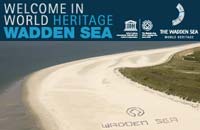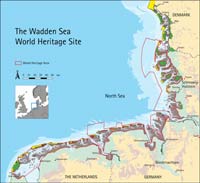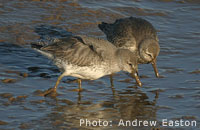Wadden Sea listed as World Heritage Site
 26
26
June 2009 - The Dutch-German Wadden Sea has been added
to the List of World Heritage Sites by the UNESCO World
Heritage Committee at its meeting in Seville (Spain) this
week (22-30 June 2009). The listing has put the Wadden Sea
on the same footing as the Grand Canyon in the USA, the
Great Barrier Reef in Australia and the Serengeti in Tanzania
along with other natural wonders of outstanding universal
value on the World Heritage List.
The new Wadden Sea World Heritage Site covers an area of
almost 10,000 square kilometres along a coastal strip of
about 400 kilometres and encompasses the Dutch Wadden Sea
Conservation Area and the German Wadden Sea National Parks
of Lower Saxony and Schleswig-Holstein, an area which represents
over 66% of the whole Wadden Sea.
 "The
"The
nomination of the Wadden Sea as World Heritage Site is a
recognition of the international importance of the Wadden
Sea as one of the main breeding, staging, moulting and wintering
areas for millions of migratory waterbirds. It is one of
the most important refuelling stations for many of our birds."
said Bert Lenten, Executive Secretary of AEWA, a United
Nations Environment Programme (UNEP) administered treaty
dedicated to the conservation of migratory waterbirds in
Africa and Eurasia.
“AEWA applauds the decision taken by UNESCO to list
the Wadden Sea as World Heritage Site and hopes that this
will support the conservation of this important site for
the flora and fauna that depends on it.” said Lenten
on behalf of the 62 countries which have signed the international
Agreement. 
The Wadden Sea is considered as one of the most important
wetlands for migratory waterbirds in the world. Many waterbird
species using the East Atlantic Flyway, such as the Red
Knot (Calidris canutus), the Bar-tailed Godwit
(Limosa lapponica) and the Curlew (Numenius
arquata), depend upon the area's uniquely varied landscape
of inter-tidal mudflats, salt marshes and sand banks both
as a major stop-over site to refuel for their long journeys
between their breeding and wintering areas, or as a site
to stay in winter.
Some waterbird species such as the Shellduck (Tadorna
tadorna) also use parts of the Wadden Sea to moult
in late summer. Most birds staying in the Wadden Sea, feed
during low tide at inter-tidal mudflats and congregate in
large flocks at communal high tide roosts, often found at
the edges of salt marshes, on sand flats and beaches.
The Wadden Sea’s large temperate, relatively flat
coastal environment is heavily formed by the constant flow
of tides, which have given rise to a multitude of transitional
habitats with tidal channels, mudflats, salt marshes, sea-grass,
meadows, estuaries, beaches and dunes.
In addition to being a breeding and wintering area for
up to 12 millions birds per year, the Wadden Sea provides
habitats for more than 10,000 plant and animal species,
including marine mammals such as theharbour seal, grey seal
and harbour porpoise.
For more information on the Wadden Sea World Heritage Site
please visit the following website:
www.waddensea-worldheritage.org
Further Information:
- Film:
Welcome in the Wadden Sea (
English / WMV File) - UNESCO
Press Release: Wadden Sea, Italy’s Dolomites and
Philippines’s Tubbataha Reefs Natural Park inscribed
on UNESCO’s World Heritage List ( 26 June
2009) - Common
Wadden Sea Secretariat Press Release: Wadden Sea inscribed
on the World Heritage List (26
June 2009)
Other related news:
Last updated on 16 June 2014


